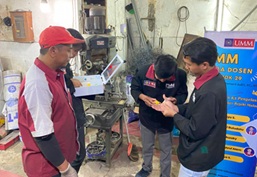Optimalisasi Proses Pengelasan di Bengkel Sumber Rejeki Malang dengan Teknologi Gas Tungsten Arc Welding Optimization of the Welding Process at Sumber Rejeki Workshop Malang using Gas Tungsten Arc Welding Technology
Main Article Content
Abstract
Sumber Rejeki Welding Workshop is one of the small and medium enterprises engaged in manufacturing and welding services in Malang City. In its production process, the workshop still relies on conventional welding methods that are less efficient and produce suboptimal weld quality. Therefore, this community service program aims to enhance production efficiency and quality by implementing Gas Tungsten Arc Welding technology and assisting in applying occupational health and safety standards. The implementation method of this program includes several stages: the preparation stage, which involves identifying partner needs and machine installation; the training stage, consisting of theoretical and practical sessions for operators; the production assistance stage; and the evaluation stage, using the Non-Destructive Testing method with penetrant testing techniques to assess weld quality. The results of this program implementation indicate a 30% improvement in production efficiency, with reduced processing time and fewer welding defects. Significant economic impacts are also evident through increased production capacity and the workshop's competitiveness in the local market. Furthermore, the provided training has enhanced the operators' skills in machine operation and raised their awareness of the importance of occupational safety standards. This program demonstrates that adopting modern welding technology can significantly improve productivity and product quality, making it a potential model for application in other small and medium enterprises to boost competitiveness in the manufacturing sector.
Downloads
Article Details

This work is licensed under a Creative Commons Attribution-ShareAlike 4.0 International License.
Authors who publish with this journal agree to the following terms:
- Any article on the copyright is retained by the author(s).
- Author grant the journal, right of first publication with the work simultaneously licensed under a Creative Commons Attribution License that allows others to share work with acknowledgment of the work authors and initial publications in this journal.
- Authors are able to enter into a separate, additional contractual arrangements for non-exclusive distribution of published articles of work (eg, post-institutional repository) or publish it in a book, with acknowledgment of its initial publication in this journal.
- Authors are permitted and encouraged to post their work online (e.g., in institutional repositories or on their websites) prior to and during the submission process, as can lead to productive exchanges, as well as earlier and greater citation of published work.
- The article and any associated published material is distributed under the Creative Commons Attribution-ShareAlike 4.0 International License
References
Amin, Z. (2024). Hand Related Injury Studies in Metal Fabrication Process Industry. In Asia Pacific Environmental and Occupational Health Journal, 10,(5). https://satudata.kemnaker.go.id/satudata-public/2022/10/files/publikasi/1675661836215_The%2520Indonesian%2520OSH%2520Profile%25202022_Compiled%252020230124_compressed.pdf
Atmojo, Y. P., Hostiadi, D. P., Susila, I. M. D., Srinadi, N. L. P., Hilmi, M. R., & Ayu, P. D. W. (2024). Pengembangan Varian Produksi dan Pelatihan Keselamatan Kerja pada Usaha Mikro Kecil Menengah Bengkel Las. PengabdianMu: Jurnal Ilmiah Pengabdian Kepada Masyarakat, 9(8), 1489–1498. https://doi.org/10.33084/pengabdianmu.v9i8.7180
Buang, A., Abu Bakar, M., & Rohani, M. (2024). A Review Of Trend Advanced Welding Process And Welding Technology In Industries. International Journal of Technical Vocational and Engineering Technology, 5(1), 133–145. www.pktm.my
F S Putra, F. I., Haziroh, A. L., Aqmala, D., & Azzura, E. (2025). DATING : Digital Marketing Training and Empowerment Program to Increase Solo Raya Souvenir MSMEs Sales Performance. JOCESS : The Journal of Community Empowerment and Sustainability Services, 1(1), 1–10. https://doi.org/10.32815/jpm.v5i1.1242
Kah, P., & Martikainen, J. (2012). Current Trends in Welding Processes and Materials: Improve in Effectiveness. In Rev. Adv. Mater. Sci (Vol. 30). https://www.ipme.ru/e-journals/RAMS/no_23012/08_kah.pdf
Kamesha, A. D., Aziza, A. H., Lubis, A. F., & Zaharani, Y. T. (2024). Kesehatan kerja dan penyakit akibat kerja kasus kondisi emergensi di tempat kerja. Public Health Risk Assesment Journal, (2). https://doi.org/10.61511/phraj.v1i2.2024.568
Manh, N. H., Nguyen, V. A., Le Duy, H., Akihisa, M., Le, V. T., Ngoc, T. Q., & Gandham, B. (2022). Development of a novel GTAW process for joining ultra-thin metal sheets. Journal of Manufacturing Processes, 80, 683–691. https://doi.org/10.1016/j.jmapro.2022.06.043
Shams, S., Hussain, T., Shaikh, S. A., Shams, B., & Bhurgri, J. (2019). Performance Analysis of SMAW Welding and GMAW-FCAW Combined Welding for Pipeline Construction Jobs at SSGC. Pakistan Journal of Science, 71(4), 278–282. https://apicee.org/Files/Paper1%20(48).pdf
Thakur, P., Thakur, P. P., & Chapgaon, A. N. (2016). A Review on Effects of GTAW Process Parameters on weld. International Journal for Research in Applied Science & Engineering Technology (IJRASET), 4(1), 136–140. https://doi.org/10.13140/RG.2.2.11535.38569
Vimalraj, C., Kah, P., Mvola, B., & Martikainen, J. (2016). Effect of Nanomaterial Addition Using GMAW And GTAW Processes. In Rev. Adv. Mater. Sci (Vol. 44). https://www.ipme.ru/e-journals/RAMS/no_44416/04_44416_vimalraj.pdf
Yu, W., Fan, M., Shi, J., Xue, F., Chen, X., & Liu, H. (2018). A comparison between fracture toughness at different locations of SMAW and GTAW welded joints of primary coolant piping. Engineering Fracture Mechanics, 202, 135–146. https://doi.org/https://doi.org/10.1016/j.engfracmech.2018.09.021
Zhang, Y. M., Yang, Y.-P., Zhang, W., & Na, S.-J. (2020). Advanced Welding Manufacturing: A Brief Analysis and Review of Challenges and Solutions. Journal of Manufacturing Science and Engineering, 142(11). https://doi.org/10.1115/1.4047947
